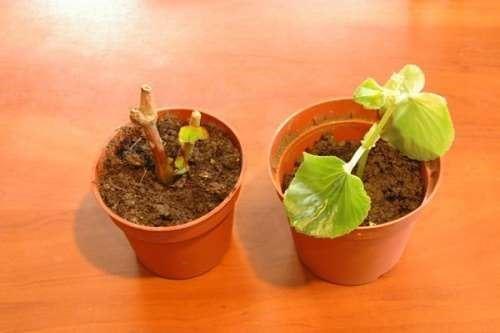Growing ever-flowering begonia from cuttings
 Ever-flowering begonia is popular not only among indoor florists. It serves as a decoration for a summer garden or flower bed, as it fully justifies its name. The fallen inflorescences are replaced by new ones and this continues throughout the season.
Ever-flowering begonia is popular not only among indoor florists. It serves as a decoration for a summer garden or flower bed, as it fully justifies its name. The fallen inflorescences are replaced by new ones and this continues throughout the season.
One of the fastest breeding methods ever-flowering begonia - get a new plant from a cutting. Most often it is used to rejuvenate an old plant, especially after the winter period, when the shoots on the windowsill stretch out in search of light. From one flower, you can get several new begonias, which will actively grow again and delight them with flowering.
How to root the stalk correctly?
A feature of begonias is a thick, fleshy stem that contains a large supply of moisture. This must be taken into account when rooting a cut cuttings.
Most gardeners advise rooting begonia in water. But often such an attempt ends in decay, because the stalk itself is half water. Therefore, it is better to reproach him immediately in the ground.
You cannot root a freshly cut cutting, you need to leave it to lie down for a while so that the cut site dries up and tightens. You can plant begonias when droplets of juice no longer stand out from the cut.
If there are buds on the upper shoot, they must be removed, as well as the lower leaves. They will only draw out excess juices. Before planting, treat the cutting itself with a growth stimulant of the Kornevin type.
Soil preparation
To propagate begonias by cuttings, you will need a light nutritious substrate for flowering plants. If you cannot purchase a special soil mixture, you can prepare it yourself by mixing:
- garden land;
- humus;
- some sand.
Put a layer of expanded clay at the bottom of the flowerpot, and only then add soil.
Creating the conditions for successful rooting
In order for the begonia shoot to sprout faster, greenhouse conditions can be created for it. To do this, place a glass jar or a cut plastic bottle on top. However, begonia takes root well even without shelter.
Place the pot in a warm, well-lit place. Spray periodically, preventing the soil from drying out, but not flooding it.
It is good to use a spray bottle for this. When a new bud appears from the axil of the main leaf, the begonia should be watered more often.
A strengthened young bush in the summer is recommended to be placed outside or transplanted to a flower bed. In the open air, the plant develops better and blooms actively.
Please tell me, I have ampelous begonia, but not tuberous. For some reason, the leaves sharply decreased and the buds began to fall off, there are no visible pests.
Perhaps your begonias are lacking in nutrients, so the leaves and buds are chopped up and fall off. Problems with flowering and leaves can also occur if the irrigation regime is violated, when there is too much moisture or, conversely, not enough. Dry air and drafts also contribute to these problems. Try feeding the flower with complex fertilizer and watering. If the situation does not change and the fall continues, you will have to remove it from the pot and examine the roots.
Hello, please tell me.I don't know exactly what my begonia is called, but you may be able to help me. A couple of days after the purchase, I noticed a white bloom on the leaves, I thought it was dust, wiped it with a dry cloth, then I read on the Internet that this is a mealy disease (I may not call it correctly) it is written that it is necessary to remove the leaves affected by this pest, I cut off everything from I was left with a bare trunk. By the way, there is also a white coating on the trunk itself. Can I help you to fix my stupidity ??? Help please, I really love my flowers.
This is not a pest, but a fungus, and this disease is called powdery mildew. Treat the remaining flower with a fungicide (Skor, Topaz, Baikor) and move the pot to a cool and well-ventilated area so as not to infect other plants. Most likely, begonia "picked up" him where he lived earlier. The cause of powdery mildew is often high humidity and temperature.